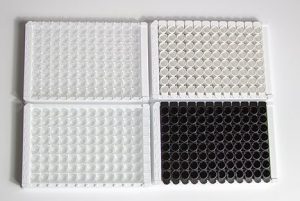No products in the cart.
ELISA Coating and Blocking
Protocol and Tips
Choose your proper ELISA Plate
As an important step of ELISA Coating and Blocking Protocol and Tips choosing of your Elisa plate is important.Polystyrene is a Hydrophobic plastic polymer that resists interacting with hydrophilic compounds. All proteins have a hydrophilic surface that does not tend to absorb on hydrophilic surfaces! So, plate manufacturers make some additives to polystyrene to limit their hydrophobicity and extend their hydrophilic boundaries. This is done to make two types of high binding and low binding plates. In fact, high binding ELISA plates have more hydrophilic surface than low binding plates. High binding ELISA plates are suitable plates for most globular proteins, synthetic antigens, and Antibodies while low binding plates are proper choice to lipoproteins, most hydrophilic proteins, and whole extracted proteins.
What is the best Concentration of Coating protein in ELISA coating Buffer?
To find out optimized concentration of your target protein, it is better to perform ELISA Checkerboard Test. It can obviously be a helpful method to achieve a solid opinion about the range of concentration of your protein that works in your coating.

ELISA Coating and Blocking Protocol and Tips
What is the best ELISA Coating Buffer?
ELISA Coating and Blocking Protocol and Tips
Coming back to the coating mechanism, first we should need a buffer that provides a PH above or below our protein P.I. It is considered that Carbonate/ Bicarbonate buffer with PH=9.6 and PBS with PH=7.4 is proper choice. In fact, for some glycosylated Antibodies and Antigen they work well but you need to add some Protease inhibitors, Stabilizers, Antioxidants, or emulsifiers to keep your protein physiologically stable and reactive after your coating. It is important especially when you coat Antigen for Direct and indirect ELISA or sensitive proteins like streptavidin. All in all, for general and non-sensitive works we can use CBB or PBS successfully, but for sensitive proteins and research it is better to use commercial ELISA Coating Buffers.
How does an ELISA Plate Blocking solution work?
ELISA Plate Blocking solution is a buffered solution that keeps your coated Ag 3rd structure safe during drying. Also, it blocks empty sites of Plate that have not been coated. At the same time, ELISA Plate Blocking solution is a stabilizer for coated proteins and extend their shelf life. A proper ELISA Plate Blocking solution can reduce non-specific binding and decrease ELISA background signal and increase the sensitivity and specificity of ELISA tests. It has antimicrobial compounds to inhibit the growth of germs and some additives for decreasing the oxidation of your coated proteins. ELISA Plate Blocking solution is a multi-action reagent in one formula.
Protocol of Direct and Indirect ELISA Plate Coating
ELISA Coating and Blocking Protocol and Tips
- Dilute coating antigen to a final concentration of 0.5-3 μg/mL using ELISA Coating Buffer. Coat the 96 well ELISA plate with the antigen by pipetting 100µl of the diluted antigen. Seal the plate and incubate overnight at 4℃ or 4h at room temperature.
- Wash plate 3 times with ready to use PBS.
- Block the remaining protein-binding sites in the coated wells by adding 150µl ELISA Blocking Buffer.
- Cover the plate with an adhesive plastic and incubate for 1h at room temperature.
- Note: Never Wash the Blocked plates, just discard extra buffer and let plates dry up-wards for 18 hours at RT or 2 hours at 37 ℃. Then put coated plates in proper bags with moisture absorbent.
- Also, you can perform your ELISA test promptly after blocking (without drying) if you need.
QC test of your ELISA Coated Plates in Direct and Indirect ELISA methods
- Bring out coated plates and ELISA components 30 Min before starting the test.
- Pick 12 wells and put inside an empty plate. (Return back remained coated well strips to 4℃)
- Add 100 µl ELISA Sample Diluent to each well.
- Add 10 µl ELISA negative Control, Positive control, 2 Positive Sample and 2 Negative sample to wells in duplicate.
Note: In this step you can make pre diluted samples in proper test tubs and then transfer 100 µl of dilution to your wells. Also, you can use commercial serum controls and positive and negative standards.
- Cover the plate with an adhesive plastic and incubate for 30 Min to 1h at room temperature or 37℃.
- Wash plate 3 times with ready to use ELISA Wash Buffer.
- Add 100 µl ELISA Conjugate Buffer and incubate for 30 Min to1h at room temperature or 37℃.
- Wash plate 3 times with ready to use ELISA Wash Buffer.
- Add 100 µl ELISA Grade sensitive TMB Substrate and put plate in dark for 10Min.
- Add 100 µl ELISA stop solution to stop the reaction.
- Read results in less than 10 Min.
Protocol of Competitive and Sandwich
ELISA Plate Coating
- Dilute coating Antibody to a final concentration of 2.5-5 μg/mL using ELISA Coating Buffer. Coat the 96 well ELISA plate with the Antibody by pipetting 100µl of the diluted Antibody. Seal the plate and incubate overnight at 4℃ or 4h at room temperature.
- Wash plate 3 times with ready to use PBS.
- Block the remaining protein-binding sites in the coated wells by adding 150µl ELISA Blocking Buffer.
- Cover the plate with an adhesive plastic and incubate for 1h at room temperature.
- Note: Never Wash the Blocked plates, just discard extra buffer and let plates dry up-wards for 18 hours at RT or 2 hours at 37 ℃. Then put coated plates in proper bags with moisture absorbent.
- Also, you can perform your ELISA test promptly after blocking (without drying) if you need.
QC test of your ELISA Coated Plates for Competitive and Sandwich ELISA methods
ELISA Coating and Blocking Protocol and Tips
- Bring out coated plates and ELISA components 30 Min before starting the test.
- Pick 16 wells and put inside an empty plate. (Return back remained coated well strips to 4℃)
- Add 20 µl standard (6 standard from 0 to maximum biological concentration), 1 Low concentration control and 1 high concentration control in duplicate.
- Add 100 µl ELISA Enzyme conjugate.
Note: In this step you can use commercial serum controls and positive and negative standards or make your own Conjugate by diluting HRP-Ag / HRP-Ab in ELISA Conjugate Stabilizer reagent.
- Cover the plate with an adhesive plastic and incubate for 1 to 2h at room temperature or 37℃.
- Wash plate 3 times with ready to use ELISA Wash Buffer.
- Add 100 µl ELISA Conjugate Buffer and incubate for 30 Min to1h at room temperature or 37℃.
- Wash plate 3 times with ready to use ELISA Wash Buffer.
- Add 100 µl ELISA Grade sensitive TMB Substrate and put plate in dark for 10Min.
- Add 100 µl ELISA stop solution to stop the reaction.
- Read results in less than 10 Min.



